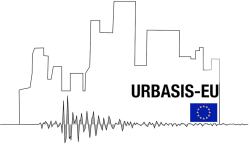WP3 - Urban seismology, engineering seismology and earthquake engineering
Inelastic linear and non-linear soil behaviour - we will develop and test new methods to measure the amplification and damping of seismic waves, and non-linear soil behaviour in sedimentary basins. Non-invasive active and passive seismic methods are used with the aim of mapping the characteristics of the soil cover over large areas. The calibration of advanced rheological models is performed using in-situ measurements. We will develop strategies to map soil responses over large areas using proxies and empirical correlations. Participants : ETHZ, IFSTTAR, UGA, RESONANCE.
Array seismology - with the analysis of earthquake recordings and ambient vibrations at the urban scale, it will be possible to retrieve information about the subsurface geology and soil responses in different areas of a city. This relies on dense networks of seismic stations deployed in and around the city. With the noisy urban environment and the presence of many seismic sources within the network, it will be necessary to develop specific processing techniques. This includes strategies to infer 2D/3D characteristics of buried structures and an approach to model propagation of inelastic diffuse wave-fields in complex media, including the effect of wave interactions with buildings.
Site-city interactions - we aim to experimentally demonstrate that a dense urban environment can behave in many ways as a meta-material for seismic waves. The idea is that each building inside the city can react as a resonator that traps a small part of the seismic surface waves. The collective behaviour of the buildings when arranged in a dense urban area such that several structures are present inside one seismic wavelength would then correspond to the physics observed at a very small scale (<1 micrometre) in optical meta-materials, when electromagnetic waves interact with nano-materials. The design of a seismic meta-material that can ‘hide’ any kind of human structure from the damage that can be caused by seismic events through a natural ‘cloak of invisibility’ would be a societal revolution in the field of seismic hazard.
High-performance numerical tools – we aim to improve existing high-performance numerical tools to demonstrate the feasibility of using 3D-physics-based approaches to model the complete seismic responses of a city to a given earthquake, considering as a benchmark the case studies of the L’Aquila (2009) and Christchurch (2011) earthquakes.
Vulnerability assessment of buildings and infrastructure - we will improve typical vulnerability assessment of reinforced concrete and masonry structures as well as infrastructure components, such as bridges, levees, embankments, and tunnels, by incorporating soil-foundation-structure interactions (SFSI), structure-soil-structure interactions (SSSI) and ageing effects (2D/3D numerical approaches).
Updated on 4 juillet 2022






